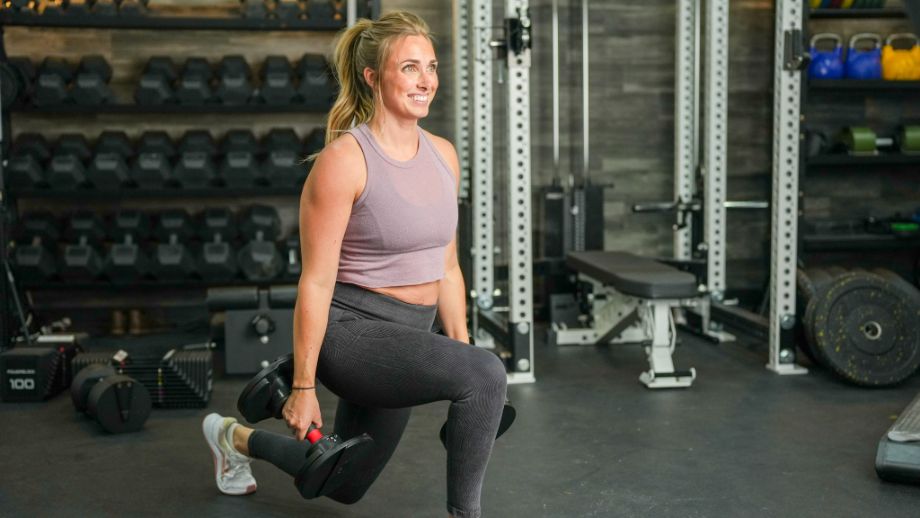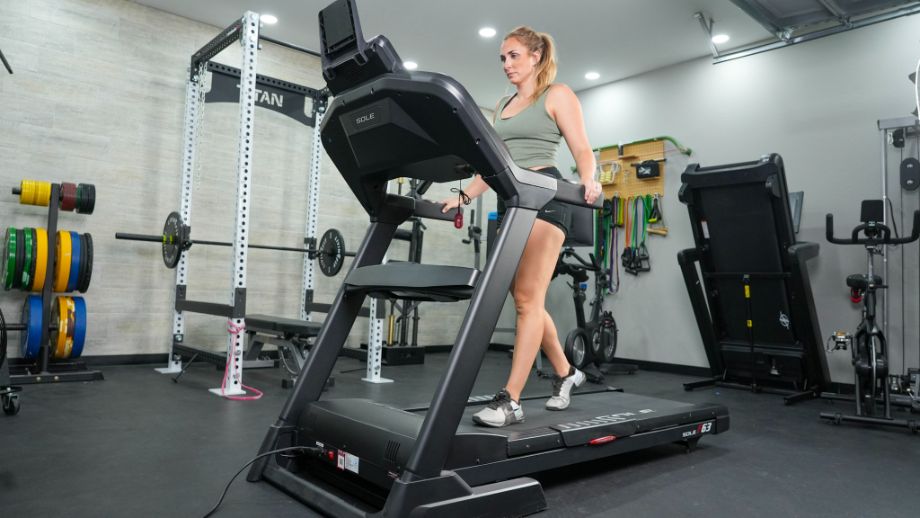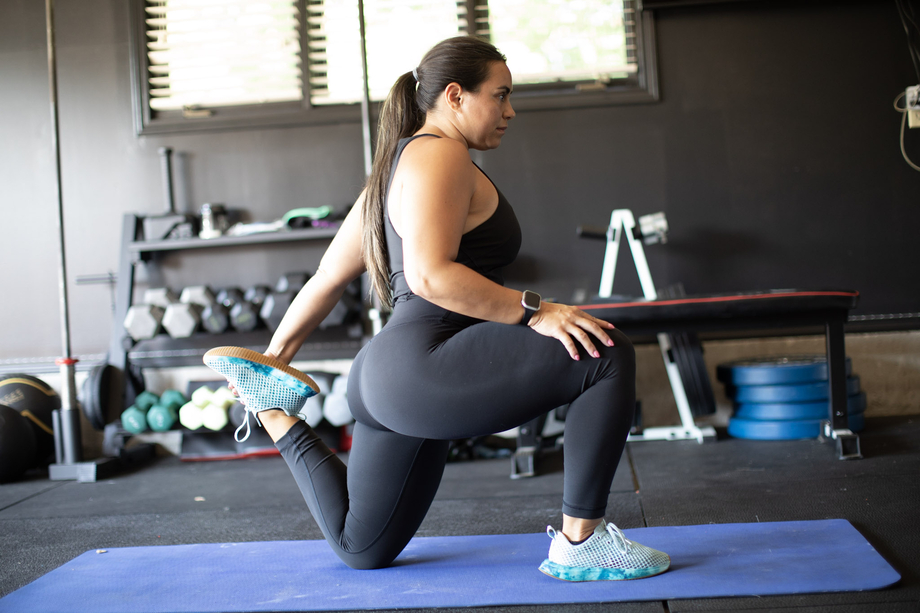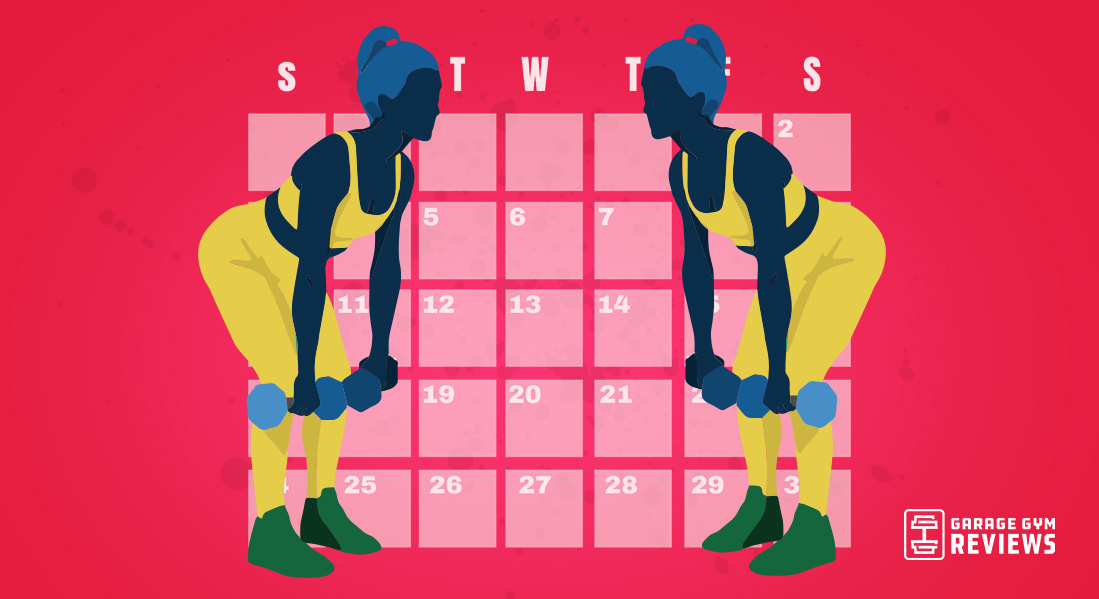We test and review fitness products based on an independent, multi-point methodology. If you use our links to purchase something, we may earn a commission. Read our disclosures.
When you’re new to exercise, it may be tempting to find a workout schedule that puts you on the fast track to success. I’m a certified personal trainer, and I’m here to tell you this: there is no fast track. So, if you’re brand new or returning to exercise, let’s take baby steps to get to your ideal routine.
When I create a workout schedule for beginners, I start with two days of basic weight lifting at home and about three days of moderate intensity cardio, like walking.
I know you want to dive into fitness head-first and reap the benefits of strength training. But please take it slow. I’ve seen over-enthusiastic clients walk into a gym for a consultation and tell me they want to schedule three or four personal training sessions per week, only to cancel those sessions because of soreness. Not only that, it may be tough to find the time to get your workouts in more than a few times each week. The struggle is real!
Types of Exercise Ideal For Beginner Workout Schedule
I’m here to help you avoid rookie mistakes by outlining a few things I think are important to know about workout schedules including frequency, exercise selection, and how to approach your active recovery days.

First, I’m going to share the three different types of exercise I like to program for beginners: resistance training, cardio, and active recovery. I know not every trainer (or lifter) will agree with me on this, but I think training styles like interval training and HIIT should be used once you’ve established quality movement patterns with basic exercises like the goblet squat and lunges. The last thing a beginner needs is a workout program that features jump squats and minimal rest while they’re still getting the hang of full range of motion squats without their knees internally rotating.
RELATED: Benefits of HIIT
With my small disclaimer out of the way, here are the three training methods I like to include in my workout schedule for beginners:
Resistance Training
If you have zero experience with resistance training, performing exercises like squats, lunges, glute bridges, and push-ups can all be done using your own bodyweight. However, getting acclimated to moving your body’s resistance is no small feat.
RELATED: At-Home Bodyweight Workout

Once you have more practice moving your own body through some of the fundamental movement patterns (squatting, hinging, pushing, and pulling), adding resistance with some of the best adjustable dumbbells (or kettlebells) is an effective home workout method because you’ll get a range of dumbbell weights within one small space. Resistance bands are also effective for beginners and experienced lifters alike. Barbells are not necessary for most beginners, and I don’t suggest investing into a barbell setup until you’ve established an exercise routine.
RELATED: Hip Hinge Exercises
Another thing I’ll note about resistance training for beginners: In my experience, starting with full-body workouts (that focus on the major muscle groups) just twice per week is ideal. It ensures you won’t hit the muscles of your lower body (or upper body) too hard on a given day, and you’ll be ready for your next session.
Cardiovascular Exercise
The heart is made up of muscle tissues1 and needs to be worked just like your hamstrings, quads, or upper body. While your heart won’t grow or build muscle like your arms from bicep curls, the tissues of the heart need to undergo strain to contribute to perform well and efficiently. We work the heart muscles when we increase our heart rate for extended periods of time (like walking, hiking, running, biking, swimming, or dancing).
I think it’s also important to mention that the CDC2 recommends that adults get at least 150 minutes of moderate to vigorous activity each week. That means about 20 minutes every day of the week or 30 minutes of exercise five days per week.

I have no doubt that you will be able to reach 150 minutes of exercise every week, but don’t stress if you’re not there yet. I’ll have you aim for anywhere between 20 to 40 minutes of moderate cardio exercise. At first, aim for 20 minutes and see if you can increase it over time. Keep in mind that you can do two 10-minute walks or bouts of cardio.
RELATED: Best Cardio Exercises for Beginners
Active Recovery
Active recovery is a crucial part of your new exercise routine, but what is active recovery? Essentially, it’s low-intensity movement following high-intensity training (which, in this case, is your two days of strength training).

Active recovery can include moderate (and low-impact) cardio like walking, cycling, and swimming. It also includes stretching, yoga, foam rolling, or massage guns. Some folks may even utilize saunas and cold plunges on active recovery days.
Later in this article, I’ll outline some of the best mobility exercises for beginners that are easy to do at home.
Sample Week Workout Schedule For Beginners
I mentioned earlier that I think beginners should start with two days of strength training. I know you’re gung-ho and ready to go, but you’ll still be moving your body every day on this workout schedule for beginners.
Here is a sample of how I like to schedule a week of workouts:
| Training Overview | |
| Day 1 | Full-body strength training: Workout A |
| Day 2 | Moderate cardio of your choice: 20-40 minutes |
| Day 3 | Moderate cardio of your choice: 20-40 minutes |
| Day 4 | Full-body strength training: Workout B |
| Day 5 | Active recovery day: Mobility and stretching |
| Day 6 | Moderate cardio of your choice: 20-40 minutes |
| Day 7 | Rest day |
Sample Month Workout Schedule For Beginners
Now that you know what a week of workouts should like, here is what is looks like when you have a program set up for an entire month:
| Day 1 | Day 2 | Day 3 | Day 4 | Day 5 | Day 6 | Day 7 | |
| Week 1 | Full-Body Workout: A | Cardio | Cardio | Full-Body Workout: B | Active Recovery | Cardio | Rest |
| Week 2 | Full-Body Workout: A | Cardio | Cardio | Full-Body Workout: B | Active Recovery | Cardio | Rest |
| Week 3 | Full-Body Workout: A | Cardio | Cardio | Full-Body Workout: B | Active Recovery | Cardio | Rest |
| Week 4 | Full-Body Workout: A | Cardio | Cardio | Full-Body Workout: B | Active Recovery | Cardio | Rest |
Examples of Full-Body Workout Routine
Now that we’re on the same page about a workout schedule for beginners, here is an example of two full-body workouts I’ve used with beginner clients:
Full-Body Training Workout A
You’ll get a little bit of everything in this workout including deadbugs at the end, which work your core and stability. Quads (the front of your legs) and shoulders will be worked the most on this day.
| Exercise | Sets | Reps |
| Goblet Squat | 3 | 8-12 |
| Standing Dumbbell Shoulder Press | 3 | 8-12 |
| Incline Push-Up | 3 | 8-12 |
| Reverse Lunge | 3 | 8-12 |
| Lateral Shoulder Raise | 3 | 10-15 |
| Isometric Deadbug Hold | 3 | 20-30 seconds |
Full-Body Training Workout B
Another mix of everything, but with a focus on your posterior chain (aka the backside of your body). You’ll work the glutes, hamstrings, upper back, and triceps on this day.
| Exercise | Sets | Reps |
| Glute Bridge | 3 | 10-15 |
| Romanian Deadlift | 3 | 8-12 |
| One-Arm Dumbbell Row | 3 | 8-12 |
| Bodyweight Triceps Dip | 3 | 8-12 |
| Farmer’s Carry | 3 | 30-40 seconds |
| Low Forearm Plank | 3 | 20-30 seconds |
Sample Progression Goals For Beginner Strength Workouts
You may be looking at the chart above and thinking, “That’s boring.” Trust me, I get it. It’s a ton of repetition. You’ll be bouncing between full-body workout A and full-body workout B, with cardio and mobility sprinkled in between. But, we have to repeat and practice the same exercises to get better at them and build muscle mass.
Plus, there are ways to make this repetitive training more interesting.
The trick is called progressive overload. This training principle allows you to progress your strength and overall fitness level through a variety of methods not limited to just overall weight lifted. For beginners, I think the best way to move through a month of training is to adjust the load, repetitions, and sets.
With more experience, you can begin to manipulate your range of motion, rest time between exercises, training frequency, and the degree of difficulty when you select an exercise.
Here’s how I like to schedule progression for beginners:
| Progression Goals Per Week | |
| Week 1: Create a baseline | Perform exercises with body weight or light weights. Dialing in your form on the first week is your priority. |
| Week 2: Try more weight | Stick with the same exercises from last week. Determine which exercises you’ll be able to add weight to or increase the load (it doesn’t have to be for every movement, and the increase can be as little as 5 pounds). If there is a certain exercise that can’t be loaded with more weight, try adding two more repetitions. |
| Week 3: Add an additional set | With more practice under your belt, you’ll repeat the same exercises with either the same load as last week (or a tad more if you’re up for it) and aim to add one more set to each exercise. This increases your overall volume and work capacity. |
| Week 4: Deload; reduce weight and sets | Don’t skip this week! The last few weeks have added more weight and more sets to your training. It’s time to reduce your weights to self-selected light-to-moderate loads and decrease volume to just 2 sets of every exercise. |
Examples of Active Recovery for Beginners
Here are my favorite upper body mobility drills for beginners. We have in-depth explanations and visual aids for each in our thoracic mobility exercise guide:
- Cat-cow pose
- Thread the needle
- Iron cross stretch
Plus, these are my absolute favorite lower body stretches for beginners. Each can be found with full step-by-step directions in our hip flexor exercise guide:
- World’s greatest stretch
- Pigeon pose
- 90/90 stretch
Other Resources for Beginners
If this workout schedule for beginners helps you, you can check out our other resources and workout guides for beginners:
Final Thoughts on Workout Schedule For Beginners
In order to reach your health and fitness goals, you have to start somewhere. If you’re not used to exercising or carving out time in your day for exercise, it’s extremely important to start with just a few days per week so it doesn’t feel overwhelming.
When I build workout schedules for beginners, I like to start with two full-body strength training sessions per week, three days of moderate intensity cardio (like walking), and one day of active recovery and stretching.
For a solid launching point, use the charts above to curate your first month of working out. The Full-Body Training Workouts A and B in the charts above are designed for minimal equipment and at-home workouts. Give it a try, you got this!
Workout Schedule For Beginners: FAQs
What is a good workout schedule for beginners?
If you’re new to weight training, ease yourself into a routine with one or two full-body workouts per week. In addition to strength training, it’s ideal to add in moderate cardio to meet the CDC recommendation2 of 150 minutes of moderate to vigorous exercise per week. If you can start with one or two days of both lifting and cardio, you’re on the right track to creating healthy habits that can last a lifetime.
How long should I do beginner workout?
Speaking as a personal trainer, stick with your beginner workout program for at least four weeks. You can use the principles of progressive overload to enhance even the most rudimentary workout plan.
How should my workout schedule be?
As a certified personal trainer, when I work with beginners, I think it’s essential to start with just one or two days of strength training and a few days of moderate cardio. I think starting small can help you overcome the hurdles of carving out the time for a new endeavor. Don’t underestimate small wins—you can always build and stack habits on those small successes.
References
- Ripa R, George T, Sattar Y. Physiology, Cardiac Muscle. StatPearls [Internet]. Treasure Island (FL): StatPearls Publishing; 2023 Jan-.
- Centers for Disease Control and Prevention. How much physical activity do adults need? 2023, June 2.
Further reading

These shoes claim to relieve foot pain, but do they really work? Find out what our testers thought in this KURU ATOM shoes review. Read more

Do you know which of these milk proteins is best for your fitness goals? Check out the differences in our comparison of casein protein vs whey. Read more

When you’re new to exercise, it may be tempting to find a workout schedule that puts you on the fast track to success. I’m a certified personal trainer, and I’m here to tell you this: there is no fast track. So, if you’re brand new or returning to exercise, let’s take baby steps to get to your ideal routine. When I create a workout schedule for beginners, I start with two days of basic weight lifting at home and about three days of moderate intensity cardio, » Read more about: Workout Schedule For Beginners: Baby Steps to a Complete Fitness Routine » Read more

Are you looking to build boulder shoulders? We’ve got the best shoulder exercises to add to your workout, and stat! Read more

